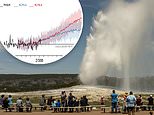
Climate change could completely shut off Yellowstone’s Old Faithful geyser, which has been active for hundreds of years, a new report warns.
Researchers at Montana State University, the US Geological Survey (USGS) and the University of Wyoming released a climate assessment this week that states if temperatures rise above 10 degrees Fahrenheit, the geyser will likely stop erupting.
The report warns that by 2100, rising temperatures could transform the lush 3,000-square-mile area into a region plagued by drought.
Although the stark warning still has 80 years to become a reality, such an event happened about 800 years ago – Old Faithful stopped erupting for decades due to extreme heat and a lack of precipitation.
Scroll down for video
Climate change could completely shut off Yellowstone’s Old Faithful, which has been active for hundreds of years
Old Faithful was first discovered in 1870 by the Washburn Expedition, which explored northwestern Wyoming for two years, but experts believe it has been existence for thousands of years.
The geyser received its name for its frequent and somewhat predictable eruptions, which expels 3,700 to 8,400 gallons of water each time it erupts – which is about every 60 to 110 minutes.
However, the latest climate report warns Old Faithful could cease to exist because climate change is slowly taking over Yellowstone National Park, according to The Guardian.
According to the assessment, temperatures in the area have increased by more than two degrees Fahrenheit since 1950 and are expected to rise another five to 10 degrees by the end of the century.
A climate assessment this week states if temperatures rise above 10 degrees Fahrenheit the geyser will likely stop erupting
Yellowstone is also set to see an annual precipitation increase of up to 15 percent, but with elevated temperatures and higher evaporation rates, the region will likely have drier summers.
‘Geologic records indicate that decade-long periods of low precipitation have occurred in the past 1,200 [years],’ reads the report.
‘These dry periods were times of reduced snowpack, more fires, lower streamflow, establishment of trees above present tree line, and even a near-century hiatus in geyser activity of Old Faithful.
‘Megadroughts occurred in the GYA [the Greater Yellowstone Area] and across much of the western United States in the early 600s, late 800s, 1200s, and late 1500s.
‘These dry periods led to more fires, desiccation of small lakes, reduced streamflow, an upslope shift in upper tree line, and reduced Old Faithful geyser activity.’
Some 800 years ago, one of these megadroughts affected the Greater Yellowstone Area and stopped Old Faithful from erupting for about 130 years.
Researchers said that the geyser stopped erupting long enough to allow trees to grow in the area between the years 1230 and 1360.
These findings were reported in a 2020 study published in Geophysical Research Letters.
This study concludes that since climate change models predict severe drought by the middle of this century, it is likely Old Faithful will either see extremely long intervals of eruption or cease erupting altogether – the same conclusion made by researchers of the new climate change assessment.
Although the stark warning still has 80 years to become a reality, such an event happened about 800 years ago – Old Faithful stopped erupting for decades due to extreme heat and a lack of precipitation
Steve Hostetler, a USGS scientist and co-lead author of the report, said in a statement: ‘Greater Yellowstone is valued for its forests, rivers, fish and wildlife.
‘The trend towards a warmer, drier climate described in this study will likely affect ecosystems in the region and the communities that depend on them.’
The team studied climate change in the Greater Yellowstone Area from 1950 through 2018 and found the average temperature has increased approximately 2.3 degrees, with the most warming observed at elevations above 5,000 feet.
Researchers also note that Bozeman, Montana, and in Jackson, Pinedale and Cody, Wyoming are all likely to experience 40 to 60 days in the year that are exceeding 90 degrees by the end of the century.
The team studied climate change in the Greater Yellowstone Area from 1950 through 2018 and found the average temperature has increased approximately 2.3 degrees, with the most warming observed at elevations above 5,000 feet
Cathy Whitlock, Regents Professor Emerita of Earth Sciences at Montana State University and report co-lead author, said in the statement: ‘The assessment is intended to provide the best available science on past, present and future conditions in the GYA so that stakeholders have needed information to plan ahead.’
Geologic studies done for the report also highlights the effects of climate change over recent decades, showing the average temperature was as high or higher than any period in the last 20,000 years and likely the warmest of the last 800,000 years, according to geologic studies.
Source link
CHECK OUT: Top Travel Destinations
READ MORE: Travel News



